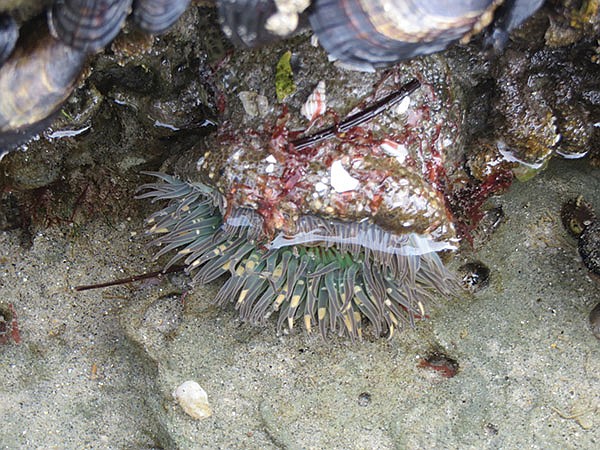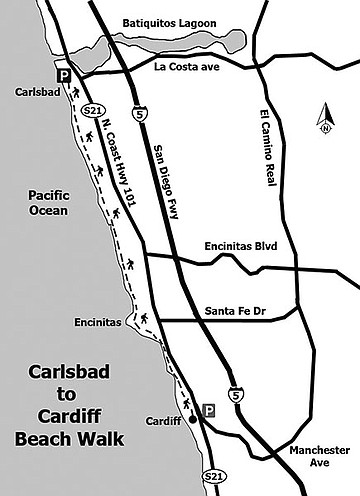 Facebook
Facebook
 X
X
 Instagram
Instagram
 TikTok
TikTok
 Youtube
Youtube

One of the advantages of having a long coastline is an abundance of beach hiking opportunities beyond the tourist crush zones. This hike combines a relaxing beach walk with tide pools and can be done either as a 10-mile round-trip or as a 5-mile one-way by having a car at each end of the route. The route starts in Carlsbad near the mouth of the Batiquitos Lagoon at GPS coordinates N33 05.131 W117 18.720 and ends at the San Elijo State Beach in Cardiff at N33 01.000 W117 16.955. Check the tide schedule before you go and try to time the hike for low tide for the best view of the tide pools.

Walking down the coast on the beach, note the battle that local homeowners have with cliff erosion. While ice plant appears to provide a good, fast-growing ground cover, its roots are not deep. In heavy rains, the mat gets heavy and can slide down the hill, making erosion worse. The ice plant also presents a unique fire hazard. The new plant growth showing on top looks green, but there may be a foot-and-a-half of flammable dead material underneath. This under-layer can burn quickly beneath the live layer on top, creating an effect like a chimney. Unfortunately, the more stable dune-forming plants take much longer to establish, so the battle against the forces of erosion continues.
Look for piles of kelp that wash ashore. The piles attract sand flies, but fortunately these do not bite people and are only attracted to the kelp. The flies provide an important source of protein for shore and migratory birds. Creatures that frequent the kelp beds, such as bean clams and moon snails, are often washed ashore with the kelp. Eel grass is also frequently washed ashore. Interestingly enough, eelgrass is not seaweed, but a flowering plant (an angiosperm). The eel grass acts as a nursery for young fish.
Also look for beach-rounded cobbles originating from the Lindavista Formation, similar to layers found in Tecolote Park. You will pass Moonlight Beach, which is a restored riparian area. This route is a prime opportunity for bird-watching. In addition to gulls and pelicans, keep an eye out for grebes, long-billed curlews, marbled godwits, royal terns, and many others.

If hiking at low tide, view tide pools and the associated marine creatures as you near Cardiff. The anemones are quite delicate, so avoid stepping on them. They can be surprisingly hard to recognize at low tide. Anemones tend to collect bits of broken shells on their outer surface. When they curl up as the water level draws down, the shells protect the anemones from the sun. At first glance, you may think you are looking at an area strewn with broken shells. Closer inspection will reveal dozens of curled-up anemones.
Other sea creatures commonly found clinging to the rocks include gooseneck barnacles, mussels, chitins, small crabs, and sand tubeworms. These creatures are filter feeders. They build their tubes out of sand grains that they cement together with calcium secretions. The calcium is absorbed from the ocean by the worms. The tubes are very delicate despite their rock-like look and can easily be crushed with fingers. Treat these creatures gently to avoid hurting them.
Limpets tend to look a bit like part of the rocks, but if they are stuck tight to the rock, it means they are alive. Limpets can create burrows in the rock over time. If you take a close look at the rocks where the creatures live, you will notice that there are fossilized invertebrates under the live creatures. You are witnessing the ongoing development process of a reef.


One of the advantages of having a long coastline is an abundance of beach hiking opportunities beyond the tourist crush zones. This hike combines a relaxing beach walk with tide pools and can be done either as a 10-mile round-trip or as a 5-mile one-way by having a car at each end of the route. The route starts in Carlsbad near the mouth of the Batiquitos Lagoon at GPS coordinates N33 05.131 W117 18.720 and ends at the San Elijo State Beach in Cardiff at N33 01.000 W117 16.955. Check the tide schedule before you go and try to time the hike for low tide for the best view of the tide pools.

Walking down the coast on the beach, note the battle that local homeowners have with cliff erosion. While ice plant appears to provide a good, fast-growing ground cover, its roots are not deep. In heavy rains, the mat gets heavy and can slide down the hill, making erosion worse. The ice plant also presents a unique fire hazard. The new plant growth showing on top looks green, but there may be a foot-and-a-half of flammable dead material underneath. This under-layer can burn quickly beneath the live layer on top, creating an effect like a chimney. Unfortunately, the more stable dune-forming plants take much longer to establish, so the battle against the forces of erosion continues.
Look for piles of kelp that wash ashore. The piles attract sand flies, but fortunately these do not bite people and are only attracted to the kelp. The flies provide an important source of protein for shore and migratory birds. Creatures that frequent the kelp beds, such as bean clams and moon snails, are often washed ashore with the kelp. Eel grass is also frequently washed ashore. Interestingly enough, eelgrass is not seaweed, but a flowering plant (an angiosperm). The eel grass acts as a nursery for young fish.
Also look for beach-rounded cobbles originating from the Lindavista Formation, similar to layers found in Tecolote Park. You will pass Moonlight Beach, which is a restored riparian area. This route is a prime opportunity for bird-watching. In addition to gulls and pelicans, keep an eye out for grebes, long-billed curlews, marbled godwits, royal terns, and many others.

If hiking at low tide, view tide pools and the associated marine creatures as you near Cardiff. The anemones are quite delicate, so avoid stepping on them. They can be surprisingly hard to recognize at low tide. Anemones tend to collect bits of broken shells on their outer surface. When they curl up as the water level draws down, the shells protect the anemones from the sun. At first glance, you may think you are looking at an area strewn with broken shells. Closer inspection will reveal dozens of curled-up anemones.
Other sea creatures commonly found clinging to the rocks include gooseneck barnacles, mussels, chitins, small crabs, and sand tubeworms. These creatures are filter feeders. They build their tubes out of sand grains that they cement together with calcium secretions. The calcium is absorbed from the ocean by the worms. The tubes are very delicate despite their rock-like look and can easily be crushed with fingers. Treat these creatures gently to avoid hurting them.
Limpets tend to look a bit like part of the rocks, but if they are stuck tight to the rock, it means they are alive. Limpets can create burrows in the rock over time. If you take a close look at the rocks where the creatures live, you will notice that there are fossilized invertebrates under the live creatures. You are witnessing the ongoing development process of a reef.